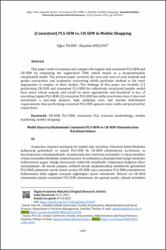| dc.contributor.author | Yıldız, Oğuz | |
| dc.contributor.author | Kelleci, Alpaslan | |
| dc.date.accessioned | 2023-11-17T17:33:53Z | |
| dc.date.available | 2023-11-17T17:33:53Z | |
| dc.date.issued | 2023 | en_US |
| dc.identifier.issn | 2148-4287 | |
| dc.identifier.issn | 2148-7189 | |
| dc.identifier.uri | https://hdl.handle.net/11363/6444 | |
| dc.description.abstract | This paper seeks to examine and compare the regular and consistent PLS-SEM and
CB-SEM by employing the augmented TAM, which stands as a proportionately
complicated model. The present paper presents the pros and cons of each method and
guides researchers and academics concerning which particular method is the most
appropriate to employ in their studies. The findings of this paper are twofold: (1)
performing CB-SEM and consistent PLS-SEM for reflectively structured models would
have more robust outputs and would be more appropriate and beneficial in lieu of
executing regular PLS-SEM; (2) consistent PLS-SEM has softer provisions since it does not
necessitate a two-step analysis, high sampling sizes and normal distribution
requirements, thus performing consistent PLS-SEM appears more viable and practical for
researchers. | en_US |
| dc.description.abstract | Araştırma, nispeten karmaşık bir model olan artırılmış Teknoloji Kabul Modelini
kullanarak geleneksel ve tutarlı PLS-SEM ile CB-SEM yöntemlerini incelemeyi ve
karşılaştırmayı amaçlamaktadır. Araştırmada, her yöntemin avantajları ve dezavantajları
ortaya konmakta böylelikle araştırmacılara ve uzmanlara çalışmalarında hangi yöntemin
kullanımının uygun olduğu konusunda rehberlik etmektedir. Çalışmanın bulguları ikiye
ayrılmaktadır. ilk olarak çalışma, reflektif olarak yapılandırılmış modellerde geleneksel
PLS-SEM yöntemini tercih etmek yerine CB-SEM veya consistent PLS-SEM yöntemlerini
kullanmanın daha sağlam sonuçlar sağladığına işaret etmektedir. İkincisi ise CB-SEM
yönteminin aksine consistent PLS-SEM yönteminin, iki aşamalı analiz, yüksek örneklem hacmi ve normal dağılım şartları gibi katı koşullar gerektirmemesi araştırmacılar için
daha elverişli bir yöntem olduğunu göstermektedir. | en_US |
| dc.language.iso | eng | en_US |
| dc.publisher | İstanbul Gelişim Üniversitesi Yayınları / Istanbul Gelisim University Press | en_US |
| dc.relation.isversionof | https://dx.doi.org/10.17336/igusbd.1014138 | en_US |
| dc.rights | info:eu-repo/semantics/openAccess | en_US |
| dc.rights | Attribution-NonCommercial-NoDerivs 3.0 United States | * |
| dc.rights.uri | http://creativecommons.org/licenses/by-nc-nd/3.0/us/ | * |
| dc.subject | CB-SEM | en_US |
| dc.subject | PLS-SEM | en_US |
| dc.subject | consistent PLS | en_US |
| dc.subject | research methodology | en_US |
| dc.subject | mobile marketing | en_US |
| dc.subject | mobile shopping | en_US |
| dc.subject | consitent PLS-SEM | en_US |
| dc.subject | araştırma metodolojisi | en_US |
| dc.subject | mobil pazarlama | en_US |
| dc.subject | mobil alışveriş | en_US |
| dc.title | (Consistent) PLS-SEM vs. CB-SEM in Mobile Shopping | en_US |
| dc.title.alternative | Mobil Alışveriş Düzleminde Consistent PLS-SEM ve CB-SEM Yöntemlerinin Karşılaştırılması | en_US |
| dc.type | article | en_US |
| dc.relation.ispartof | İstanbul Gelişim Üniversitesi Sosyal Bilimler Dergisi | en_US |
| dc.department | İktisadi İdari ve Sosyal Bilimler Fakültesi | en_US |
| dc.authorid | https://orcid.org/0000-0003-2164-975X | en_US |
| dc.authorid | https://orcid.org/0000-0003-1589-2905 | en_US |
| dc.identifier.volume | 10 | en_US |
| dc.identifier.issue | 2 | en_US |
| dc.identifier.startpage | 649 | en_US |
| dc.identifier.endpage | 667 | en_US |
| dc.relation.publicationcategory | Makale - Ulusal Hakemli Dergi - Kurum Öğretim Elemanı | en_US |
| dc.contributor.institutionauthor | Yıldız, Oğuz | |



















